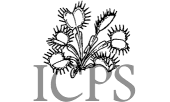|
Carnivorous Plant Newsletter
Volume 30, Number 4, December 2001, pages 111 - 116
NEW CULTIVARS
Dionaea ‘Jaws’
Sarracenia ‘Hummer's Hammerhead’
Sarracenia ‘John's Autumnal Splendor’
Sarracenia ‘Hummer's Okee Classic’
Sarracenia ‘Super Green Giant’
Sarracenia ‘Golden-Red Jubilee’
Sarracenia ‘Green Rosette’
Sarracenia ‘Harvest of Gold’
Dionaea ‘Jaws’
Received: 20 October 1999
This
plant is the result of the breeding program at California State
University, Fullerton. On 3 June 1993, I crossed Dionaea
‘Dentate Traps’ (see Carniv. Pl. Newslett. 29, p16),
a wild-collected plant with its marginal tentacles mutated into
short teeth, with a plant we grow which is noteworthy for its consistently
extra large, moderately red-colored traps. This plant was selected
from the seedlings. The margins of the trap are dentate like the
pollen parent. Like the seed parent, the traps are consistently
large, with good coloration. The plant is vigorous and even though
the traps do not have normal cilia, they do trap insects. Other
siblings are being evaluated.
The cultivar epithet, ‘Jaws’, is named for the remarkable
shark-like aspect of the partially closed traps (Figure 1). The cultivar name
was inspired by the movie “Jaws”, and refers to the
large traps and the form of their marginal spines; I nominated this
name in (approximately) 1995, and it was submitted for registration
by Barry Meyers-Rice on 20 October 1999. The preferred method of propagating
this plant is by vegetative means, in order to maintain the characters
of the teeth and traps.
LEO SONG, JR. • Fullerton, CA • USA

Figure 1: Dionaea 'Jaws'. Photograph by Leo Song.
Sarracenia ‘Hummer's Hammerhead’
Received: 1 December 1999
This
plant has the parentage Sarracenia (psittacina
x alabamensis) x alabamensis, and is a very vigorous
grower. Its outstanding features are best noted in the late season,
autumnal leaves which are unmistakable. (Early season leaves show
much less pronounced features.) This plant is particularly notable
for the upright, pubescent leaves, which together with the bright
coloration of yellow gold and numerous areolae and bright red venation
throughout. Most striking is the elongated, flattened, and somewhat
downwards pointing hood. The plant is overall quite compact, since
the pitchers are usually 10-20cm (4-8 inches) in length. The flower
petals are deep red, and contrast nicely with the bright golden
pitcher leaves. In order to maintain these characters, this cultivar
should be propagated vegetatively.
I developed this cultivar in May 1992. The name was coined in
1996 by Bill McLaughlin. The cultivar name notes the peculiar shape
of the pitcher hood.
JOHN HUMMER • Arlington, VA • USA
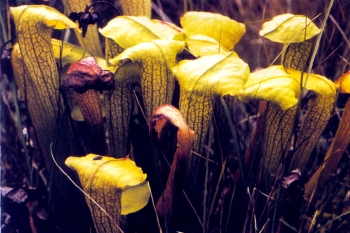
Figure 2: Sarracenia 'Hummer's Hammerhead'
Sarracenia ‘John's Autumnal Splendor’
Received: 1 December 1999
This
plant has the parentage Sarracenia jonesii x alabamensis. The plant
is a fairly robust grower with leaves averaging 25-50 cm (10-20
inches) in length and which are slightly pubescent. The hood is
undulate and often pointed at the tip. The leaf coloration varies
according to the intensity of sunlight it is grown in. The lower
third of the leaf is green with some red venation. The upper two-thirds
of the leaf exhibit deep red color throughout, and venation that
tends towards golden yellow on and around the hood. This results
in a striking effect when seen from a distance. Specimens growing
in full sun, and undisturbed for years can become a deep maroon
throughout, with only a hint of yellow-gold here and there. Flower
petals are a deep maroon color. In order to maintain the complex
cultivar characters, this cultivar should be propagated vegetatively.
I developed this cultivar in the 1980s. I coined the name in 1988.
The cultivar name notes the beautiful gold and brown colors in the
fall leaves.
JOHN HUMMER • Arlington, VA • USA
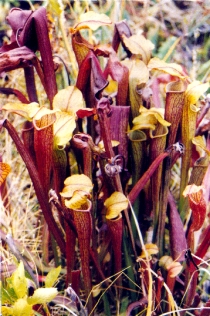
Figure 3: Sarracenia 'John's Autumnal Splendor'
Sarracenia ‘Hummer's Okee Classic’
Received: 7 April 1999
This
plant is a cross between a Sarracenia alabamensis and a Sarracenia
minor ‘Okee Giant’. The hybrid is a fairly robust grower
with pubescent leaves that reach 30 cm (12 inches) or more in height.
The hood of the leaf is distinctly convex, and is maroon in color
when grown in full sunlight. The leaf tube is a melange of green
and gold, with the upper rear third of the pitcher leaf exhibiting
numerous areolae. These areolae are distinctly veined with red pigment.
The flower petals are showy, with pastels of both red and yellow
blended together. In order to maintain the complex cultivar characters,
this cultivar should be propagated vegetatively.
I developed this cultivar in 1991 and coined the name on 6 April
1999. The cultivar name refers to the obvious influence of the pollen
parent.
JOHN HUMMER • Arlington, VA • USA

Figure 4: Sarracenia 'Hummer's Okee Classic'
Sarracenia ‘Super Green Giant’
Received: 18 November 1999
This
Sarracenia (psittacina x jonesii) x rubra
subsp. gulfensis is notable because all of its parent plants
are anthocyanin-free. The plant is entirely anthocyanin-free, a
robust grower, and upright. The hood is convex with a rounded appearance.
The pitcher leaves are gently curving, and areolae are present on
the rear upper third of the pitcher leaf. Pitcher leaves are 20-30
cm (8-12 inches) or more in height. The flower petals are green.
In order to maintain the complex cultivar characters, this cultivar
should be propagated vegetatively.
I developed this plant in the 1990s and nominated it on 18 November
1999. The cultivar name refers to the large size and green color
of the plant.
JOHN HUMMER • Arlington, VA • USA
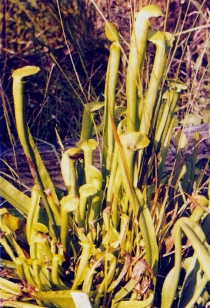
Figure 5: Sarracenia 'Super Green Giant'
Sarracenia ‘Golden-Red Jubilee’
Received: 24 December 2000
This
plant has a cross between Sarracenia jonesii and Sarracenia alabamensis.
While this is the same parentage as my cultivar Sarracenia ‘John’s
Autumnal Splendor’, the Sarracenia jonesii parent is from
a different location, and the two cultivars are different in overall
effect.
While always an attractive plant, this plant really shows off
in the late summer and autumn--the leaves have heavy, dark venation
set against a deeply golden background. The dramatic leaves, glowing
in the late afternoon sun of October, give the plant the notice
and prestige it deserves! These leaves are erect, 20-35 cm (8-14
inches) in height, and bear almost oversized lids with slightly
undulating margins. The flower petals are very dark maroon, as expected
for this cross.
In order to maintain these characters, this cultivar should be
propagated vegetatively.
I developed this cultivar in May 1997. I coined the name 27 December
2000. The cultivar name notes the nice coloration and pattern of
the mature plants, late in the season.
JOHN HUMMER • Arlington, VA • USA
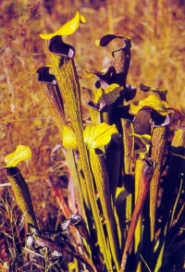
Figure 6: Sarracenia 'Golden-Red Jubilee'
Sarracenia ‘Green Rosette’
Received: 24 December 2000
This
cultivar name applies to anthocyanin-free clones of Sarracenia psittacina.
The one shown in the photograph was originally collected from Gulf
County, Florida. This specimen is fairly robust and readily produces
clonal offsets. It also selfs well and produces many seed which
germinate readily after a four week stratification period. As expected
for an anthocyanin-free variant of this species, it is entirely
green except for the numerous white areolae. The flower petals are
a creme-yellow.
In order to maintain the primary cultivar characteristic of being
anthocyanin-free, this cultivar should be propagated either vegetatively,
or by crossing two anthocyanin-free Sarracenia psittacina parents.
I selected this cultivar in May 1988. I coined the name 27 December
2000. The cultivar name refers to the anthocyanin-free form of the
plant.
JOHN HUMMER • Arlington, VA • USA
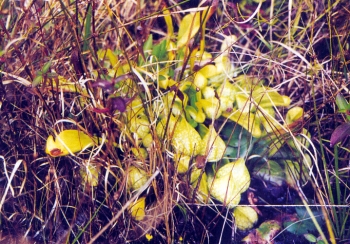
Figure 7: Sarracenia 'Green Rosette'
Sarracenia ‘Harvest of Gold’
Received: 24 December 2000
This
plant has a cross between Sarracenia alabamensis and Sarracenia
rubra subsp. gulfensis. The leaves are pubescent, 20-30 cm (8-12
inches) in height, and the leaf hoods are undulate. The cultivar’s
showiest leaves are produced in the summer to early fall. These
show traits of both parents--there is a pronounced darkened gold
background color to the pitchers, enhanced by distinct vertical
red venation throughout the leaf. These characteristics are much
less obvious in the spring or early summer leaves. The flowers have
deep maroon petals.
In order to maintain these characters, this cultivar should be
propagated vegetatively. This is easy because it is a robust grower
and forms clonal offsets readily.
I developed this cultivar in April 1988. I coined the name 11
April 1999. The cultivar name notes the attractive golden and red
colors that are expressed most strikingly during the fall.
JOHN HUMMER • Arlington, VA • USA

Figure 8: Sarracenia 'Harvest of Gold'
|
